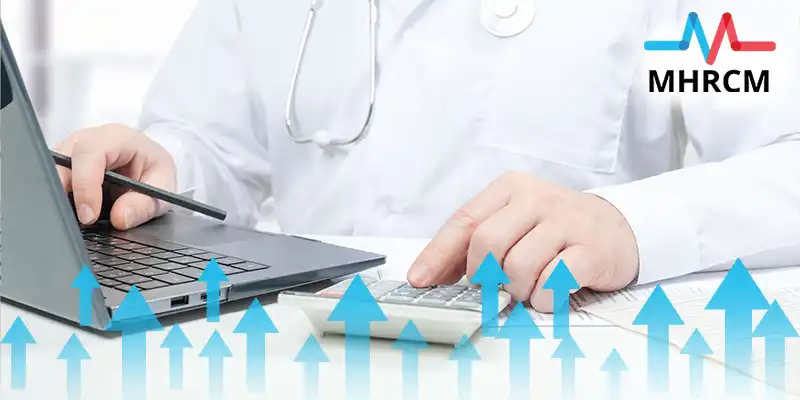By Leo John
Well, speaking about Emergency Department (ED), compared with the other healthcare departments, ED has its own set of issues. Not just for a single process, but for every practice operation, Billing, Coding, Staffing, Efficiency and Cash Flow. This is because everything is incorporated, right?!
The reason behind the challenges in the Emergency Room is that patients are admitted immediately with no or incorrect insurance information, and emergency room billing difficulties are numerous and complicated.
Among the challenges, obtaining maximum collection from the Insurance Companies is the most challenging aspect. So, in this article, we’ll explain to you the influential Accounts Receivable Management and the solutions for the problems.

A/R Management 101: What is A/R in Emergency Department?
Before we jump right into the solution, let’s explain Healthcare Account Receivable Management.
Once a Healthcare Bills a Patient or Insurance Company for services rendered, the money they owe is called Account Receivables.
Typically, practices measure Account Receivables as “Days in A/R.”. This is measured by dividing the total amount by the practice’s average daily charges. For instance, if your practice is 30 days in A/R, you’ve not been paid for 30 days of work.
Healthcare’s A/R can be classified by age (typically period of time) which is the time since the Patient or Insurance Company was Billed. In this method, A/R are placed in the aging bucket that reflects how long they have been outstanding in accounts, 0-30 days, 31-60 days, 61-90 days, and more than 90 days.
A/R Management Issues in Emergency Department
As mentioned earlier, the major issue is that Healthcare Practices are experiencing high A/R variations for the same reason. Insurance Companies and / or Patients aren’t paying money owed. The Patient Bill that has been outstanding for more than 90 days is worth less than half of its original value. Here the most common high A/R causes.
Insurance Claim Denial
High A/R is most frequently caused by Insurance Claim Denial. The majority of payments are made by the Insurance Provider, with the exception of the Patient Copay or Deductible. Cash Flow can be disrupted or even stopped by a Claim Denial.
Five common reasons for Claim Denials by Insurance Companies are incomplete or erroneous information, duplicate submissions, undisclosed procedures, coding problems, and late filing. When they can, they also tend to come up with excuses. The list of excuses is essentially endless, and includes misplaced documents, lost claims, and missing data. You are more likely to stop doing the follow-up work, if they make it more challenging for you to get compensated. For this reason, due diligence in A/R work is crucial.
Unwarranted Write-offs
Due to this, your Billing Team must establish an Approval Procedure for Modifications. Without an adequate justification, Claims shouldn’t be Modified. Generally speaking, you shouldn’t see Write-offs for reasons other than going above the maximum permissible (“Overmax”), and even then, you should check that your rates are being applied correctly.
Due to this, your Billing Team must establish an Approval Procedure for Modifications. Without an adequate justification, Claims shouldn’t be Modified. Generally speaking, you shouldn’t see Write-offs for reasons other than going above the maximum permissible (“Overmax”), and even then, you should check that your rates are being applied correctly.
Due to this, your Billing Team must establish an Approval Procedure for Modifications. Without an adequate justification, Claims shouldn’t be Modified. Generally speaking, you shouldn’t see Write-offs for reasons other than going above the maximum permissible (“Overmax”), and even then, you should check that your rates are being applied correctly.
Bad Debts
The main reason for Bad Debts is the rising deductibles and out-of-pocket costs, and many patients are unable to pay their Bills. According to the analysis of TransUnion Healthcare, 68% of Patients with balances of $500 or less didn’t pay the entire amount.
Moreover, plastic surgery has one of the highest pockets averages: $ 1,566, which places more responsibility on the Patient, when compared to many other specialties.
Collection Culture
Healthcare Practices often stay away from the Collection Culture because their main objective is Patient Care. Besides focusing on Collecting Unpaid Balances, they Value Excellent Customer Service. However, practically, Healthcare Practices must receive payment to operate continually.
In reality, many Healthcare Practices lack the necessary tools to Collect Unpaid Balances within the desired time frame. Done correctly, instituting a Collection Culture can Increase Patient Satisfaction. The Patient can understand all money owed, and your Healthcare Practice has more money available to Improve the Patient Experience.
As an Account Receivable Management Company, we would suggest setting the expectation upfront in your own Financial Policy and sticking to a Process (sending dead accounts monthly) and the guidelines. These days, the threat of a negative online review often scares Healthcare Practices away from utilizing Collections Agencies.
Well, speaking about Emergency Department (ED), compared with the other healthcare departments, ED has its own set of issues. Not just for a single process, but for every practice operation, Billing, Coding, Staffing, Efficiency and Cash Flow. This is because everything is incorporated, right?!
Steps to Improve A/R and Improve Cash Flow of Emergency Department

1. Run A/R Reports
The Healthcare Center should keep track of ongoing A/R trends and fluctuations for the best Collection, by running A/R Reports every month. The Report should include Aged Receivables to track progress with Older Bills. While running the A/R Reports, you must keep in mind to run these Reports from the Service Date instead of the Billing Date, to identify and recognize Billing Schedule Issues. The best Collection Rate can be no more than 20% over 90 days. Obviously, the Statistics will vary based on specialty, size, and payer mix. So, remember about these items.
If you take two weeks off, your monthly expenses will go down, and so will the proportion of new to old claims.
Your A/R will change if you file a lot more Workers’ Compensation Claims, than BlueCross or Medicare.
If you are a surgeon with a lesser Caseload and Surgical Claims account for the majority of your income, one Claim that is past due for records can cause X% of your Monthly A/R to be Past Due for 30 Business Days.
You probably accept a lot of prepayments, if your clinic has a sizable self-pay, cosmetic, or fee-for-service component. Don’t forget to remove these from your A/R Reports, because Pending Credits on your Accounts can greatly affect the A/R and the numbers.
2. Follow-Up with Outstanding Accounts
Patient Care is a priority, and Collecting Payments from patients with outstanding balances, is essential for the Healthcare’s Financial part. Healthcare should send frequent notices, and if the patient continues to neglect those notices, have your office follow up by phone call.
Compared with letters, phone calls are harder to ignore. By chance, if your patient is ignoring both, you may need to utilize more aggressive tools of a Collections Agency.
3. Increase Billing Cycles
Healthcare Medical Offices often mail Bills once a month. That could externally affect the Cash Flow. So, try to mail Patient Invoices once a week and Insurance Invoices twice a week. The quicker a bill arrives to the proper recipient, the sooner it can be paid.
4. Examine Claims Closely
For no further concerns, Collect and Examine your Claims for Accuracy and Completeness because Claim Errors increase A/R. Before submitting Claims, proofread your submissions to ensure Accuracy. Most Software Programs and Clearing Houses use Claim Scrubbing Tools to identify and catch Clerical and Simple Coding Errors. Make sure your Emergency Department Billing Staff is Auditing beyond these Simple Issues.
5. Check Insurance
Check to see if a New Patient’s Insurance Covers the Procedure, before the Patient comes. Determine their Financial Responsibility based on their Copay and Deductibles, after you have Validated their Eligibility. Before the Appointment, let them know, so they will know what to expect.
6. Examine Write Offs
Before sending any potential Write-offs through:
- Practice reviewing each one.
- Decide whether circumstances, based on financial requirements, medical needs, etc., demand permission.
- Be careful to exhaust all other payment methods.
7. Coleect Payment in Office
Before leaving the Office, make it a requirement that all Patients Pay their Copay. As a result, Bad Debt and Ageing Receivables will decline. This way, you can immediately find Overdue Payments. Mandate that your personnel give a Summary of the Copays they have Collected.
Additionally, several Practitioners are projecting benefits before surgery and asking for a payment equal to the full estimate or a portion. Patients are getting used to this Protocol because most Clinics use it.
A “Card on File Policy,” which Mandates that Patients Maintain an Active Credit Card on File and carry Auto-run Insurance as well, is also being adopted by several Practices. For example, all Unpaid Balances over 30 days will be run utilizing the Card on File).
8.Outsource Billing & A/R
All the steps mentioned above can help you accelerate your Cash Flow and effectively acquire Collections. Any Healthcare Practice can manage the steps to improve Collections, but for the Emergency Department, the Accuracy is questionable. Despite the unpredicting status of the Patient Entry, it’s challenging for your In-house Team to maintain a Cash Flow. Hiring an Account Receivable Management Service Company can reduce stress and manage your collections. Contact MHRCM for your A/R Management needs and get error-free Claims, Follow-ups and Increased Cash Flow.
Related Resource :
About the Author





